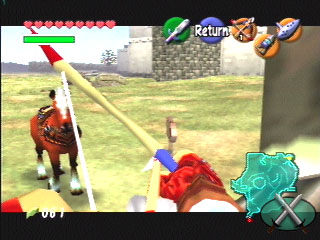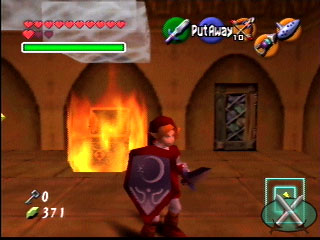|
|

|
PLATFORM
|
N64
|
BATTLE SYSTEM
|

|
INTERACTION
|

|
ORIGINALITY
|

|
STORY
|

|
MUSIC & SOUND
|

|
VISUALS
|

|
CHALLENGE
|
Moderate
|
COMPLETION TIME
|
20-40 Hours
|
|
OVERALL

|
+ Some fun boss fights.
+ Good graphics.
- Awkward camera.
- Many drawn-out parts.
- Unadjustable text speed.
- Soundtrack relies too much on ambience.
|
Click here for scoring definitions
|
|
|
In the land of Hyrule lies Kokiri Forest, populated by children with fairy companions. Among them is Link, a boy who ironically doesn't have a fairy, until one named Navi joins him, helping him embark on a quest to defeat the evil Ganondorf. Nintendo's The Legend of Zelda: Ocarina of Time marked the Zelda franchise's transition to the Nintendo 64, a system very much in need of solid titles, earning rave reception upon its release, with many proclaiming it one of the greatest games of all time. Does Ocarina of Time truly live up to the hype?
Ocarina marked the series' transition to three dimensions, with many gameplay elements from previous games present, such as the use of tools for puzzles and combat, not to mention Link's sword and shield, the former naturally allowing him to attack enemies and the latter letting him block many enemy attacks. New to this installment is the Z-targeting system, with Link able to lock-on enemies, focusing both the camera and his attacks on them, whether from his sword or tools. Z-targeting provides some convenience for tools that have made the leap to 3-D, such as the hookshot, bow and arrows, and so forth.
There are, of course, other features to note in the transition to 3-D, such as the jump system. If Link runs towards an edge, he will jump automatically (often necessary to reach other platforms), but if he walks off an edge, he will fall with his hands still holding onto the edge, with the option to fall or climb back up. The camera, furthermore, is another major feature, with the player able to shift to first-person perspective to view Link's surroundings and use the Z button to move the camera behind him, in addition to targeting enemies in his view.
 Link breaks into the animal euthenasia business
Link breaks into the animal euthenasia business
|
|
The heart system of life returns, as well, with Link able to collect Pieces of Heart scattered across the world to lengthen his HP (with four Pieces, as with before, adding another heart); defeating bosses, which still require some sort of strategy, also rewards him with an additional heart. Link can further obtain several magic spells, in addition to various elemental arrows, which consume MP. Finally, bottles that Link can find throughout his quest (up to four) can hold various useful items such as health and magic recovery potion.
Most of the time when Link is Z-targeting enemies, he can get advice from Navi on how to defeat them (even against many bosses), although this doesn't entirely make the game a cakewalk, since there will be many instances where the player will have to wrestle with the camera, since it stays quite close to Link all the time, somewhat leaving him vulnerable to enemies behind him. Combat can also be somewhat tedious when Link is close to pits and when targeted enemies are in the air (making the player blind to what's on the ground, a problem if the player is fighting near said pits or damage-inflicting floors).
Even boss fights, a strong suit in previous Zelda games, aren't as enjoyable in Ocarina given the aforementioned camera problems, which can be even greater if said bosses have several targetable appendages or more than one boss is present. Granted, healing potion can provide some room for mistakes against these bosses, although bottles are harder to obtain in this installment, given the tedium of some of the mini-games necessary to acquire them. All in all, the traditional Zelda mechanisms don't work as well in three dimensions as they could have.
 Bats can be a nuisance
Bats can be a nuisance
|
|
Gameplay outside combat also has its share of flaws in three dimensions. The four-paneled menu system, which includes a handy save-anywhere feature, however, is the best part of interaction, but the pacing of the game can feel extremely sluggish at times, given the vastness of its various environs and dungeons. Link can acquire a horse, Epona, to expedite his travel outside dungeons, not to mention several ocarina songs to warp across Hyrule, although many dungeons and other parts often feel drawn out, with a potential to get lost in the dungeons, given the constant need at times to revisit certain parts of them, as well as the complexity and vagueness of certain puzzles.
Furthermore, while Navi does sometimes allow the player to get a reminder on where to go next (although in some cases the player has to actually get lost for a while to get said reminder in the first place), there are many parts where the player can easily miss a tool needed to advance, and thus spend an eternity wandering Hyrule unless they check a guide. Other areas of the gameplay are problematic as well, such as mini-games made tedious by some of the aforementioned issues in combat, and sluggish text speed (while an option to skip through text is sometimes available, doing so skips through all the text, and can lead to missed passages). Overall, interaction is something of a chore, and can in some cases burden combat.
The changes brought about in the franchise's transition to three dimensions, though, naturally made Ocarina of Time feel like a distinct title. While many traditional Zelda elements are present, such as the setting, many characters, and tools, the developers naturally had to adapt them to 3-D, with a few new features as well such as a horse for Link and the targeting system. Like it or not, Ocarina was definitely an influential title in the series.
The first Nintendo 64 Zelda also contributes decently to the franchise's mythology, with some backstory explaining the origins of Hyrule and the Triforce, not to mention characters like Link and Ganondorf. Ocarina also has new takes on races such as the Zoras, and new species such as the Gorons and the Kokiri. The general plotline, however, is somewhat weakly paced, given the overall drawn-out nature of the game, and often doesn't feel as “epic” as the game itself. Still, the game is important story-wise to the series, and is by no means a deterrent.
 Link shows off his Turkish heritage
Link shows off his Turkish heritage
|
|
The soundtrack features a number of recognizable series themes such as a remixed overworld track and Zelda's lullaby, and many new themes such as several ocarina songs central to the plot. Though the music is decent, the aurals, particularly in dungeons and at nighttime, rely too much on ambience. Ocarina also features some occasional voicework, mostly consisting of Link's grunts and screams as well as Navi's "Hey, listen!" The latter is somewhat annoying, but the voices, while minor, don't terribly detract from the experience. Even so, the music, given the degree of ambience, could have had better presentation.
Most can agree that Ocarina of Time looked great for a Nintendo 64 game, even if the graphics are somewhat pale by modern standards. Hyrule and its inhabitants are brought to life in three dimensions, with character models, while slightly blocky, having reasonable anatomy, and environs, while with visible pixelation, being believable. The reflection effects of certain objects and areas, not to mention occasional pre-rendered scenery, are perhaps the strongest parts of the visuals. All in all, the visuals help the game more than hurt.
Finally, the first 3-D Zelda is much longer than its predecessors, taking about twenty-five hours to beat, although finding everything can naturally lengthen playing time. In the end, The Legend of Zelda: Ocarina of Time was definitely a surprise to the gaming world, given the superb reception it received, although its true quality could certainly be a matter of opinion, given the number of annoyances in this reviewer's experience from great to trivial, such as the awkward camera, many drawn-out areas, unadjustable text speed, and so forth, and those who really enjoyed prior installments of the series may or may not have a difficult time enjoying this particular iteration. After all, one's treasure can definitely be another's trash.
Review Archives
|









